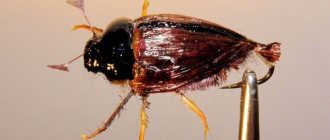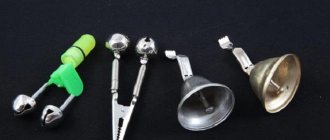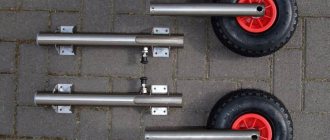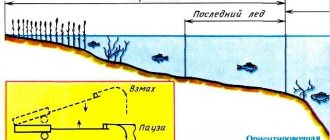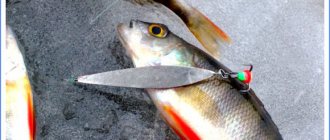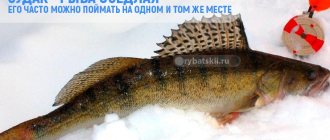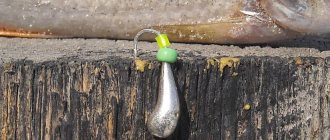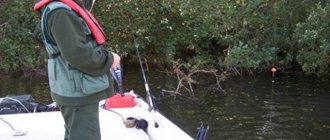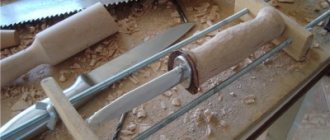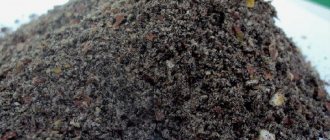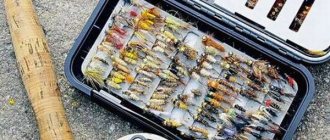Catching perch in winter requires careful preparation; you need special gear and bait. Due to the dense layer of ice, the amount of oxygen in water bodies decreases and the water temperature becomes lower. The fish's appetite and mobility decrease. To attract them, a special bait was invented, which is a copy of insects, arthropods and other inhabitants of the reservoir.
Flies for perch in winter are used to provoke perch to bite. They look like real insects and when immersed in water, the feathers and threads on them begin to move, arousing the interest of even a passive predator.
Types of flies and their features
Flies are divided into imitation and fantasy (attractors). Perch's imitation fish are associated with its usual food. In winter, there are, of course, fewer varieties of such baits than in summer. They imitate both adults and larvae, fry, and tadpoles.
The color of such bait should be natural. It is imperative to observe the proportions and sizes of real insects. The main type of fly for perch in winter is the amphipod.
There are several types of imitations:
Wet flies. They resemble drowned insects and larvae. A distinctive feature is the presence of a thin body, legs, tail and wings.
- Dry flies. They look like dragonflies, gadflies, flies, etc. floating on the surface of a reservoir. Feathers are used in production; they prevent the bait from drowning.
- Nymphs. They can be both imitation and fantasy. They imitate the larvae of various insects - mosquitoes, butterflies, dragonflies, amphipods. The color is as close as possible to the color of the inhabitants of a particular body of water.
- Streamers (wabiki). They are similar to fry (when making, you need to take into account what types of fish are found in the reservoir), tadpoles, frogs, shrimp and even small rodents. They imitate a wounded victim, attracting a predator. Must be done fairly realistically. It is heavy in weight.
- Emergers. Imitation of an insect in the stage of transformation from pupa to adult. The inactive predator is good at such bait.
Fantasy ones, on the contrary, have very bright colors - orange, red, luminescent, holographic and various metallic shades. They have no resemblance to the real inhabitants of reservoirs. They can look like anything, it all depends on the fisherman’s imagination. And they are divided into types depending on the type of fish, nutritional characteristics and behavior. This bait is of interest to the striped predator rather out of curiosity and in order to protect its space.
Catching perch with a fly in spring
During this period, the perch, having spawned, breaks into pairs and prefers non-school hunting. It behaves approximately the same way all summer until the water gets colder; in any case, it is rare that in spring and summer it is possible to catch more than two or three fish from one place. Only once in the spring did I come across a school of perch at the height of spawning. The fish greedily took the fly on each retrieve, and the males pulled out of the water were bleeding with milk. After catching and releasing a few perch, I left the spawning school alone.
Spring, as a rule, is a time of high water, so heavy and very heavy flies, often loaded with two turns of lead wire and a tungsten head, are almost always used on sinking lines and leader lines. Depending on the reservoir, food items may vary, but spring perches always eat the larvae of stoneflies, dragonflies, worms, leeches and, of course, fry with great pleasure.
If you want to catch perch in the spring, before tying a fly, you need to examine the food sources of this reservoir. My spring favorites are Montana Nymph, Large Stone Fly Nymph. I upgraded my beloved “Montana” a year after the fishing trip described above, tying it together on two half-inch copper tubes.
If necessary, a metal ball can be added between them. We had to deviate a little from the traditional Montana materials. To prevent the body from being too voluminous, I knit it from fine-fiber antron dabbing. I also make thorax flies from it, and leave all other elements unchanged. The result is a very heavy nymph that works well in high water.
Preparing gear
Equipment with such bait must be light and sensitive. In order not to miss a bite, it is necessary to use a nod; it is best to take a lavsan one. The gear also depends on the method of placing the fly on the perch for winter fishing. There are many proven and working rigging methods, here are some of them:
- Above the main bait (suspension). You need to tie the fly to a leash or to the main thread above the spinner (jig, balancer). Identified experimentally, the maximum gap above the bait is considered to be no more than 20 centimeters. If you change these parameters, the bites will decrease. The fly is tied to the fishing line with a Palomar knot. To prevent twisting, the leash is tied facing up. A leash is needed no more than five to seven centimeters.
- Below the main bait (Finnish rig). In this method, we tie the fly on a leash under a balancer or spoon, instead of its own hook. To make a leash, instead of the usual thin fishing line, we take a thicker fishing line. Soft and thin can get tangled. The size of the spinner is no more than 15 centimeters. The length of the leash and bait should be approximately the same. For example, for a balancer up to 4 centimeters long, you need a leash of a maximum of 5 centimeters.
- Sliding installation. The fly remains unfixed on the tackle, is located on the main line, and can slide up and down the line. It is fixed on the fishing line with two stoppers, between which it is located. The advantage of this method is that the distance from the bait to the fly is adjustable. This way you can choose the option for a successful catch.
- Samodur (samolov, column). This method is often used in strong currents. With this rigging method, a sinker is tied to the end of the main line. One or more flies are attached above it in combination with the necessary baits.
The advantage of the tyrant is that with a weak bite, a large number and variety of bait attracts perch better than one. But you don’t need to overdo it with the amount of bait; you can use no more than 10, so as not to tangle the gear.
We can highlight another type of gear - the “harvester”, one of the old ways of weaving gear for a predator, very popular among fishermen on Lake Baikal. A simple tackle with its own secrets.
- The flies are attached away from the main line, on which you need to tie a knot in the form of a loop and pull it out, twisting it with your fingertips. A loop is also knitted on the leash in a knot, forming a straight line with the fishing line. A leash of no more than 6 centimeters is needed. When installing it to the fishing line, it is brought in from above. This design makes the line stiffer and helps the fly play freely in the water.
- The hook with the fly is directed straight up.
- You need to ensure the correct placement of the hook and leash
The most effective fly for large catches of perch on Baikal is the bormash (amphipod crustacean); the predator readily bites on this kind of bait, despite the weather conditions and time of day.
Winter flies for perch
A relatively new, but quite well-working bait, the winter fly, very plausibly imitates the movements and behavior of a real fly. The main winter species is the amphipod, which in turn is divided into bait with and without weight. Both of these flies differ from each other only in weight: they have no external differences.
A fly without loading is used together with weighted jigs (a large “devil” can be used), and it is attached to another leash, its length can be no more than four centimeters. This leash is tied to the main fishing line at a distance of twenty centimeters from the “devil”. The bite on the described tackle does not occur on a “devil”, but on a fly. By tying a loaded fly to the hook ring, this bait can be used independently.
It is no secret that in winter, perch behaves very passively and it is not always possible to awaken its curiosity. Homemade fishermen came up with a bait, calling it a provocateur fly. This fly acts as an irritant and provokes the perch to make its first attacking movements. This bait does not look aesthetically pleasing and is not made according to the rules, but it performs its task brilliantly.
Below we provide an algorithm for tying this fly.
It is small, so the twelfth hook will do. First, the thread is wound and secured onto the shank of the hook. At the second stage, wool, previously cut into pieces, is wound onto a fixed thread. The color is bright, orange shades. Thus, the belly of the fly is formed. After this, you need to attach a cellophane strip to the back of the potential fly so that it covers the back and sides of the bait.
Then the fibers will stick out only from the bottom. They will imitate insect legs.
The cellophane film must be carefully secured to the body of the fly.
Now it’s time to form the head of the “provocateur”. It should be larger than that of a natural fly. This is necessary so that the perch pays attention to the unknown monster. You need to make several turns of thread on the body of the future fly and secure the thread to the back of the bait. If it seems to you that the fibers are sticking out in all directions, you need to pluck them out, but not cut them off, otherwise you will ruin the entire structure. The centipede was a success.
Also interesting: Balda for perch
Using green thread, you need to make the back of the fly, not forgetting that all parts of your fly are slightly larger than those of the natal insect. The diameter corresponds to the size of the head.
This “provocateur” is used in tandem with tungsten jigs, “Sakura” spinners and small balancers. If the perch does not react actively enough to this bait, an artificial bait of brightly colored maggots is suspended from the fly, increasing the parameters of the manufactured fly.
The main type of wiring includes a very fast rise, with simultaneous twitching, then the bait descends evenly and very calmly. It wouldn't hurt to take a few short breaks. Perch bites in this fishing trip occur on the descent, as the bait repeats the movements of a real amphipod. It rises to the top, then slowly floats down. When fishing with a fly, one must not forget that the perch, in its desire to attack the bait, rises, and it is necessary to control the entire horizon of the water surface.
The fuss while fishing with a fly is completely eliminated. This bait is light in weight and sinks slowly, so there is no need to rush to pick it up and tug it again. Before starting the fishing process, a loaded fly is used to quickly find the location of the perch. After detecting a parking lot, a lightweight bait is used, which works more efficiently.
Every angler prefers the fly that he has already tried, and it suits him more than other baits. But the choice of size and color of the fly remains important, since these parameters must correspond to the shape of the natural insect. Otherwise, only small fish will bite: a large one can detect the deception, and no bait will tempt it.
Even changing the wiring will not give a positive result. In each region, natural insects and their larvae have different colors. As a result of this, the perch chooses food of appropriate colors for itself. The colors mainly used are green, gray and brown. Sometimes a fish may be interested in a bright, provocative color: bright yellow, crimson, orange, etc.
Also interesting: Finding perch in winter
Author: N.K
Fishing methods
What makes this tackle so unique and good? Very often, when using only a balancer, the striped predator almost does not react to the bait. When adding flies to the tackle, the perch already perceives several objects. Under the influence of the reflex of food competition, it attacks small bait so that it does not reach larger bait. The methods and techniques for catching perch depend on the behavior of the fly prototype in nature.
There are two main ways to use a fly for winter fishing. In the first, it is used independently. In the second, in the form of complementary tackle to spinners, as well as in combination with a heavy jig.
- The first method - the sequence of actions will be as follows: the fly must be lowered to the desired depth, twitching the fishing rod with a slight amplitude, then raised. Movements should be smooth, without fuss. Similar actions can be repeated several times, changing the location and type of the fly. This method is rarely used and in addition to the front sight you still need to attach a weighting material.
- The second method is used more often; for the main bait, balancers, spinners and jigs are used. The type of wiring depends on the following factors - current, wind, air and water temperature.
Winter fly mounting options
There are quite a few options for mounting a winter fly, from which you can always choose the right one:
- Above the main bait. The latter is located at the end of the main fishing line. The fly is 15-20 cm higher (this is the optimal distance; if you increase or decrease it, there will be much fewer bites). The fly can be tied directly to the main line (it is best to use a Palomar knot for this) or on a small leash - 5-7 cm long. The leash should be knitted so that it goes up, not down.
- Sliding installation. In this case, the front sight is not fixed to the rig. It is located on the main line, along which it can slide up and down. In this case, two stoppers are used for fixation, between which the fly is located. With this installation, it will have more freedom, which in some situations has a decisive influence on the size of the catch.
- Bait mounting. In this case, a winter fly is used instead of the main bait hook. For example, it can replace the tee of a balancer or spinner. Another option is to use flies instead of witch hooks or bulldozers.
- Petty tyrant. With this rig, a sinker is mounted at the end of the main line. Above it are several winter perch flies that can be combined with other baits. We accept installation both directly on the main line and through leashes.
How to tie a fly to a fishing line quickly, simply and reliably is clearly shown in this video:
Making your own front sight
There are a huge number of different types of bait on sale. The disadvantage of ready-made ones is that the synthetic material from which they are made can have the opposite effect; instead of attracting them, they will scare away fish. But you can make them yourself. The advantage of a homemade fly is that you can make a bait with special parameters from natural materials at hand.
Required tools and materials:
- vice (for ease of working with the hook);
- scissors;
- tweezers;
- needles;
- mirror;
- looper;
- magnifying glass
- hooks (need thin No. 12-No. 14);
- mounting thread (thin, strong);
- nylon thread (durable, waterproof);
- glue;
- beads, beads of different sizes;
- bird feathers;
- animal hair;
- bright threads and yarn.
Varieties of flies
Fly fishing is a very productive activity and brings big catches. A fly is an artificial bait that imitates a natural insect.
Many of the fish that fishermen hunt are predators. These are, for example, pike, perch, asp, pike perch and many others. All of them have animal food in their diet, a large share of which comes from insect larvae and the insects themselves.
Read here Fly fishing - choice of gear, technique and options for choosing bait. 105 photos and video descriptions of fly fishing
Many insects lay eggs in the water column and on the bottom, where they gradually grow and turn into larvae, then in the process of development they rise to the surface.
In addition, insects often simply fall into bodies of water and cannot get out, which makes them prey for predatory fish. It is precisely these options that the bait called the fly imitates.
There are various varieties of flies that resemble insects in different stages of development. There are options that are identical to insect larvae of different species.
There are also nymphs - these are larvae that are slightly above the bottom, and those that are preparing to fly out of the water - these are suspenders.
Wet and dry insects are also relevant; they are caught near the surface and on the surface itself. Among the flies there are also streamers - imitation of small fish and fry.Simple manufacturing method
- First, a body is formed. To do this, you need to wind the mounting thread twice in a dense layer along the fore-end from the middle of the hook.
- Next, a small feather is tied to the hook with a nylon thread. This makes the body furry.
- The head is also made from nylon thread.
- The wings are made from stiff feather and knitted perpendicular to the hook ring.
- For the tail, you need to tie a woolen thread, placing it near the sting.
Homemade flies must be made carefully, all protruding threads must be cut off. The imitation must be of high quality; the perch can quickly consider the replacement. When making it, you need to take into account the color of the bait; the fish sees well under water. To catch bass, you need to choose both bright and dark colors. And experimentally choose a catchable bait. Dark colors include brown, black, and dark green. Among the bright ones are yellow and red.
There are no universal flies for catching perch in winter. The catch is influenced by many factors; the same fish, even within a day, can bite differently. The more diverse a fisherman’s collection of flies is, the more opportunities for successful fishing.
Ultralight flies
Spinning is perhaps the most versatile tackle, allowing you to catch a wide variety of fish using artificial bait: from huge catfish to miniature bleak. Only the gear class must match. So, in the light spinning class (light and ultralight), many spinners undeservedly (in my opinion) bypass flies. But it is with the help of flies that you can catch with a spinning rod not only predatory fish, but also almost all the others that make up the diversity of the ichthyofauna of our reservoirs.
Manufacturing technique
The simplest flies can be made from beads: we string several beads onto the shank of the hook up to the bend and wind a thread that serves as a stopper and the “head” of the fly (photo 1).
A special rubber one can also be used as a stopper. The catchability of the fly will not be affected. Another effective technique involves wrapping the shank of the hook with wire. For heavy flies we use lead wire, for light flies we use copper wire. Photo 2 shows solder winding (without rosin) with a diameter of 1 mm - a very soft and easy-to-work wire. So, we wrap the forend (as in photo 2), bite off the excess, press the ends of the wire to the forend - the front sight is ready for use (“gray nymph”). You can go over the winding with fine-grained sandpaper (“zero”) and cover it with colorless nail polish. This will emphasize the segmentation of the fly's body and protect the material from oxidation.
Several options for tinting flies with nail polish are shown in photo 3: top left - polish with glitter, top right - black, bottom left - mother-of-pearl, then red and green. The red fly is a classic "red hook" fly fishing fly made using copper wire from a telephone wire. I don’t know what kind of worm it represents, but it is very effective for morning fishing, when there is fog and there are no flying insects above the water. If you need to create something like a bloodworm, it is better to use a wire of a larger diameter (the required diameter can be easily found at an electrical store). The next simple way to create flies depicting the larvae of various insects is to wrap them with soft polymer materials. I use spandex or any other vein (of different diameters, different elasticities and different colors) sold under the brand name "beading thread" (vein flies - in photo 4). The technique for tying such flies is detailed in the table
The flies described above are smooth and, except for beaded flies, not transparent. Since transparency is recognized as one of the significant food irritants of fish, in fly fishing there is a whole direction of knitting rather complex and labor-intensive translucent structures of the “aura-nymphs” type. The translucent body of these flies is also mobile; it can “breathe”, changing its volume depending on the speed of the retrieve or the speed of the current. Some semblance of an “auranymph” is not difficult to make using shaggy yarn, such as angora or mohair (Table 2).
Photo 5 shows examples of such flies made from one color of yarn (top) and from a combination of two colors of yarn (bottom left). The two flies (center and bottom right) are made by wrapping fancy yarn with the threads sticking out to the sides. The use of such yarn creates both translucency and extreme mobility of the volume of the fly.
All models of flies can be tied on the hooks of jigs and jig heads, and, having a supply of “garlands” of sinkers with a slot (slipshot), a jig head of the required weight can be quickly made in the field by clamping the sinker at the ring of the hook (it should “look” towards the bend), and then wind the desired model of the front sight (photo 6).
When tying flies, it is impossible to do without feathers. The variety of fly patterns and feathers themselves is such that currently not a single fly fishing encyclopedia is able to describe them all. I decided to demonstrate only one here - the simplest version of the fly “midge larva” with an imitation of a gas bubble, with the help of which the larva rushes to the surface of the water, where it transforms into an adult insect. Firstly, because tied on hook No. 14 (Table 3), this fly is extremely effective in catching a wide variety of fish and even inactive fish when used with a rig with a long leader. When I want to catch white fish, I always use this fly.
If the fish is not capricious and active, then I use the same one, tied on a hook No. 12 and with a larger white bead (photo 7): it is both more noticeable and “more appetizing.” The second reason is that the feather for this fly (peacock feather) can be purchased not only at a fly fishing store, but also at the zoo and, on occasion, even on South Beach. By the way, I note that all the flies presented in this article are made from materials that can be purchased in stores that are not related to fly fishing. This is important because not every city has specialized fly fishing stores or at least departments in fishing stores selling fly fishing accessories.
Equipment and wiring Finally, a little about equipment and wiring. I almost always use the following tandem: the first fly is a “red hook” on a jig or jig head, the second is a “midge larva” on a 60–80 cm leash.
Favorite place: the reach and drain before the riffle, where the current intensifies. Having entered the water, I cast across the current (slightly up so that the tackle sinks to the bottom) and perform a retrieve with an open reel: I press the line against the side of the spool with my finger and periodically release 2-3 meters of line, sharply moving the rod back. Next, I accompany the tackle with a slow movement of the rod in the direction of the current (the flies drift near the bottom), I stop the movement of the rod when it almost touches the water (the flies float up - for the fish this is one of the signals to attack), then I release the line once or twice so that the flies drown .
The bite manifests itself either by stopping the movement of the tackle (like a hook), or by pulling, or by one or two jerks. I hook briefly, close the reel bail and land the fish.
On small rivers there are reaches with a depth that allows you to climb into the middle of the river and carry out a downstream cast, casting not only to the sides, but also directly in front of you. It is interesting that a fish, even one as careful as grayling, does not pay attention to an angler in the water, and many times I had to catch grayling, as they say, right under my feet.
In other places there is different wiring. I like jigging, both bottom and in the middle layers of water. I also like the variety of fish species that are caught with flies, because the more different fish, the tastier the fish soup.
The material was published in the January 2014 issue
